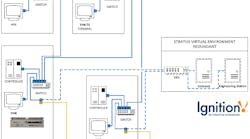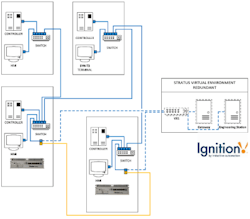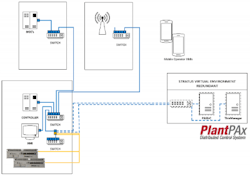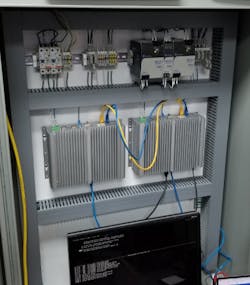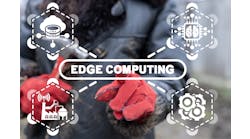Case Study: Expanding edge capabilities for end users
By Tim Shope, vice president of operations and technology at Avid Solutions
Processing and manufacturing end users are increasingly expecting product suppliers and systems integrators (SIs) to go beyond simply meeting basic automation needs.
Certainly, equipment must start, stop, interlock and perform as needed for production. But these systems must also provide rich information and diagnostics, so users can operate and maintain equipment at peak efficiency. This accelerating sophistication is compelled, in part, by end-user requirements to do more with less, with these demands met by implementing a range of improved hardware, software, and networking technologies.
For industrial operational technology (OT) systems, the term ‘edge’ has developed to describe the field locales at facilities, manufacturing sites, and remote locations where digital devices interface with sensors and actuators for monitoring and control. Modern automation and computing solutions must survive the rigors of the OT edge, while permitting seamless connectivity to on-site and cloud-based systems via information technology (IT) infrastructure. The case studies below describe how Avid Solutions converged OT and IT for their clients.
Doing more at the edge
End users are accustomed to the easy availability of information via consumer applications and the internet, and they are looking for the same level of data accessibility for industrial systems, an experience commonly referred to as the Industrial Internet of Things (IIoT). They want to remotely monitor and control their systems, and they need to analyze IIoT data for optimizing operations and responding rapidly to issues.
Proven elements such as programmable logic controllers (PLCs) and embedded human-machine interfaces (HMIs) will continue to play a role, although they are not ideal with regards to cybersecurity and data handling. PC-based systems offer the right performance when properly implemented, but many manufacturers don’t have access to the multi-discipline OT and IT teams, or to the data center and networking-infrastructure resources, to support this type of solution. Concurrently, industry suppliers and SIs have been searching for the best way to support their clients and create modern yet practical edge-capable solutions.
Following are two application examples where the Avid Solutions team developed solutions meeting these needs.
Supporting scalable pharma
Many industries are shifting to standardized modular designs, enabling re-use of design effort while providing more prefab and test options. Adding modules also is an effective way to quickly scale-up production, while minimizing required onsite installation and startup labor.
From an automation standpoint, modularity concepts can be thwarted as designers search for the best balance between deploying computing resources on each module or centralizing computing for many modules. Going too far in either direction can introduce cost and performance problems.
For one such project, the Avid Solutions team was formulating the most efficient way to architect the computing infrastructure for remotely deployable production skids. Standard automation platforms could be mounted on-skid, but lacked the desired capabilities. On the other hand, a centralized server environment would be very expensive to procure, install, and maintain—and complicated by the need to support skid quantities ranging from one to dozens.
The Avid Solutions team designed a ztC Edge redundant pair installed on-board each skid as the cost-effective and high-performance answer. Each skid benefited from complete self-sufficiency from an automation, visualization, data handling, and computing standpoint—while skids could still be arranged as peers in any number necessary, and then supervised as a whole to achieve production goals.
Remote terminal solution
Industries as varied as fertilizers, oil & gas, food & beverage, and more often rely on liquid or dry bulk material handling for transfers of raw materials, finished products, or both. Terminals are where trucks, railcars, or barges are loaded and unloaded, and a company may operate dozens or hundreds of these facilities at remote sites around the country (Figure 1).
Figure 1: Remote terminal locations are challenging sites for implementing digital technologies, so systems like the Stratus ztC Edge are the best solution for providing maintainable IT capabilities designed to perform in the OT environment.
Remote terminal locations are typically lightly staffed and have very little electrical/instrumentation/controls support. Centralized computing does not make sense for these remote sites, but each does need to communicate information back and forth with the enterprise, and ideally establish automation system consistency between sites.
In this case, the Avid Solutions team determined a ztC Edge redundant pair installed at each terminal site hit the sweet spot of capability. This was the right solution logistically and economically, especially considering several virtualized servers could be run on one compact platform to perform all computing roles. Remote technical personnel can now access the local systems over the internet, and local staff are easily engaged to change out hardware parts in the unlikely event of a failure.
Using this type of solution, operations of all sizes can realize the advantages of modern converged OT/IT designs. Each site functions as well or better than a traditionally automated operation, while gaining the remote support and data access functions required to improve operations.
An edge-computing platform
Figure 2: Modern automation and information systems of all types require edge-capable computing to merge IT communication capabilities with OT environments. This example shows a redundant pair of Stratus ztC Edge devices installed in separated locations.
The preceding examples of OT/IT convergence show the increasingly common need for architectures integrating OT-sourced data with IT-based systems. Some architectures allow for edge computing redundant pairs to be separated geographically for better resilience (Figure 2), while other systems such as production skids can install the redundant pair right on the equipment (Figure 3).
Figure 3: Skid-based designs can use a Stratus ztC Edge device pair installed right on the equipment.
Due to the increasing volume of edge-generated data and the need for low-latency processing, edge-capable computing has become vital. Stratus Technologies realized the business-critical edge computing and IIoT challenges facing many industries and designed their ztC Edge platform (Figure 4) to address these issues by providing:
- Industrial-grade robust and compact form-factor installs almost anywhere, even in a small control panel on-board machinery or equipment skids.
- Native virtualization via a built-in hypervisor, enabling developers to employ multiple independent operating systems and applications of their choice.
- Efficient hardware designs to minimize power consumption and heat generation.
- Deployed in pairs (which can be physically located some distance apart for best effect), the ztC Edge system is redundant and only a single spare CPU needs to be stocked.
- Self-protecting and self-monitoring phone-home support services drastically reduce unplanned downtime.
- End-user local personnel of nearly any skill level can easily replace problem hardware with simple plugged connections.
- After hardware replacement, software automatically restores, replicates, and synchronizes between CPUs.
Figure 4: The Stratus Technologies ztC Edge platform enables exceptionally robust computing to be installed right at the operational edge to support OT/IT convergence.
This type of platform can be configured to run core HMI applications, support remote/mobile visualization, act as a gateway between multiple intelligent devices, function as a store-and-forward data historian, perform data analysis and pre-processing, and more. The ztC Edge thus combines all the computing characteristics needed for SIs to build a supportable high-performance IIoT edge automation solution.
Conclusion
Industry is transforming and looking to incorporate contemporary IT technologies to reach the next threshold of productivity. To do so, today’s end users of all sizes are preferring a more open and interoperable approach, implemented by leveraging commercial off-the-shelf technologies.
End users still need to support their systems over the entire lifecycle, but favor options which can be serviced and maintained by the average technician, with remote support from in-house subject-matter experts or external SIs as needed.
Integrating complete automation and IIoT systems demands a wide breadth of knowledge. SIs like Avid Solutions must be familiar with countless brands of PLCs and HMI products, smart instrumentation, and specialized industrial communication protocols—as well as IT-based hardware, software, cybersecurity, cloud computing, and networking technologies. By building upon computing options like the Stratus ztC Edge platform, designers can create distributed architectures to provide optimal performance.
Figures and graphics courtesy of Stratus Technologies and Avid Solutions
